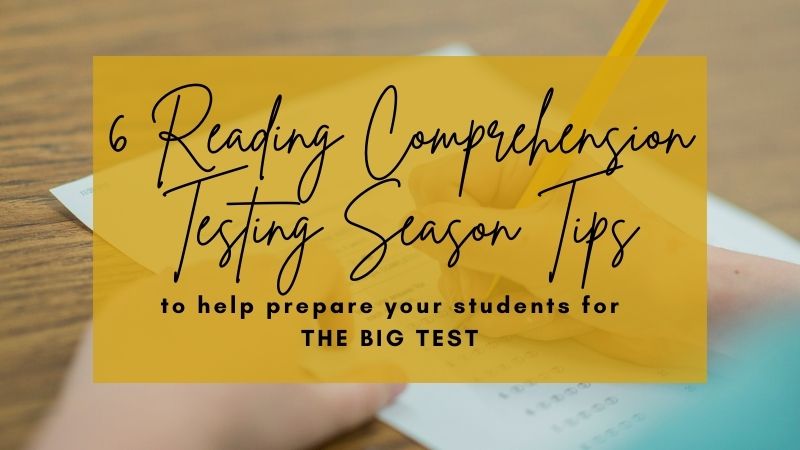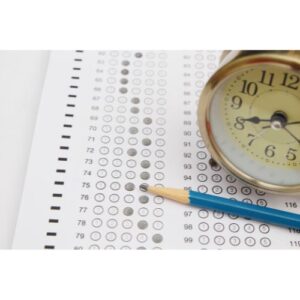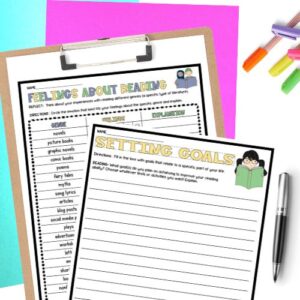No one goes into teaching thinking “I can’t wait to help my students with reading comprehension testing.” Yet it is one of the necessary, and I do say necessary, parts of teaching English language arts and reading.
Teachers cannot escape some sort of standardized testing within the public or private educational sphere. Likewise, our students cannot run from this part of academia. Reading Comprehension Testing is a part of education.
So, let’s assist our students in any way we can! We can help our students grow their skills in reading comprehension testing with a mix of determination, hard work, effective teaching, and resilience.
Need help with Reading Comprehension Testing? Check out this FREE Pack of 3 Test Prep Activities to help students achieve success on standardized tests!
Why do we need reading comprehension testing in education?
First, let me explain a little concerning the idea of reading comprehension testing as a vital element of teaching effectively.
There are 3 primary reasons why we need some sort of Reading Comprehension Testing:
- We need to know where our students are starting at. Without some sort of assessment, it is difficult to know where our students are when it comes to their abilities.
- We need to know if what we are doing as educators is actually working. Too often, I have been in professional development sessions where I have been told to teach in some way that directly contradicts what I know really works.
- We need to know if there is a trend of growth or regression. One year, I had a student who was a level 4 reading student (above average on the state test) who came to school after having a horrible experience at home. She completely underperformed due to extreme stress and earned a level 2 on the state test. The next year, she was back at level 4.
When it comes to standardized testing and/or consistent reading comprehension testing, however, there are many cons that can be avoided if schools really want to see growth.
- I am not in favor of making it the end-all-be-all for students. Students should have options and varied ways to communicate their learning.
- I am not in favor of using the test to label students for honors, AP, etc. courses. All students who desire should have access to higher-level classes.
- I am not in favor of monetarily linking growth to teachers. Students learn at different rates and newer or struggling teachers especially need help, not harsh demands.
- I am not in favor of only allowing one test to be the sole measure of progress. Offering multiple opportunities throughout the year is way more important in knowing if a student has grown.
- I am not in favor of letting big testing companies run the show. They can change the bar, craft ridiculous questions/answers, or use passages that are simply unreadable for students.
- I am not in favor of norm-referencing tests. If there is a standard, don’t keep moving the goalpost or use the test to compare to other students. Meeting the standards should be the main goal.
- I am not in favor of teaching to the test. Reading is a skill gained over time. When students read a lot, they will grow. Students need exposure to a solid phonics curriculum, a wide range and level of vocabulary instruction, and standards-based reading comprehension skills. BUT this process should be integrated throughout the year.
6 Reading Comprehension Testing Season Tips
1. REMIND YOUR STUDENTS THAT THEY CAN DO IT
This may sound like a no-brainer for reading comprehension testing tips. You might be thinking, “I encourage them to succeed by teaching them passionately every day.” And we should be teaching them with energy and excitement every day, although I am sure some days it is more of a struggle than others.
What I am talking about here is explicitly telling students that the test is here and that every kid can grow and achieve, no matter what.

Just talk with your students.
- Ask them about a time they felt overwhelmed on a test or got confused while reading or blanked out on an answer.
- Ask them about a time they felt defeated in a specific subject area in school.
- Ask them if someone has ever told them that they were not going to succeed no matter how hard they tried.
I have heard countless stories of students who were told they were not good enough, that they will never pass the standardized test, that what they do doesn’t matter, that they are just not smart enough. Like us, they need to be reminded every year, every week, every day in your classroom that they are capable of growing and achieving; the past is in the past. I think we as teachers need reminding of this truth just as much as our students.
Many students come to us with a set of skills that need refinement. We can help them every day to grow through practice, practice, practice. Most students struggle on standardized tests because they give up partway through, lose focus, and simply feel the overwhelm of the situation.
How do I grow in a specific area? I practice over and over again. Afterward, I reflect on how I am improving and then set a new goal for myself. Through constant modeling, practice, and renewal, we can teach our students that the test is just another goal to prep for and conquer.
Yes, they can do it!
2. INCLUDE TIMED ACTIVITIES TO INSTILL URGENCY
Ultimately, we all would love to have endless time on our hands to do pretty much anything we want. At any job, however, we have a specific time to accomplish a goal. It is simply a part of life.
When taking a test, especially college-entrance exams, I WISH I would have had double the time. Unfortunately, most students don’t have that option, so we as teachers have to prepare them for these timed situations.
If we want to prepare our students for the real world, then we need to offer them real-world scenarios on a regular basis.
You don’t have to be a drill sergeant; however, you can build endurance over time.
For example, have students write 1 paragraph in 10 minutes, then 2 paragraphs in 20 minutes, and so on. After months of prep, they will slowly but surely be able to write anything you ask more proficiently and will thank you when they get out into the real world where accomplishing a task in a specific time period is a must.
Want easy-to-implement reading strategies? Check out 30 strategies to help your students master reading comprehension!
3. REHEARSE TEST-TAKING SITUATIONS
It may not be the best part of the job, but there are ways you can make testing practice short, fun, and effective.
If students have to write a full essay, students can prepare by having a writing test session. But let them write about something super fun or interesting. Still, ensure that you go through the test-taking procedures with your students, so they will not be shocked on the day of the exam.
Too many students simply just don’t know the rules. They might be tempted to skip a part or put their head down. Model how to sit, how to set up their desks, how to check for time, how to go step-by-step through the exam, etc. By modeling these processes, every student can feel more comfortable on test day.
4. DEVELOP ASSESSMENTS THAT REFLECT THE EXAMS
This aspect of teaching can be overwhelming when preparing for Reading Comprehension Testing; however, there are ways to make this a simpler process. You can focus on what students will see the most. For example, most tests have writing responses, multiple-choice, multi-select, and HOT text questions. You could start by checking out question stems and answer stems that match your test.
There are so many exams out there, and you can mirror what the state test does for your own quizzes in a shorter, more student-friendly format. Try creating 3 questions and answers, or better yet, have students create their own!
Click to buy this quick and easy practice test pack modeled after state-standardized tests that help with Reading Comprehension Testing!
5. TEACH STUDENTS TO TRACK THEIR OWN PROGRESS
It blows my mind what students will accomplish when they are invested in their own learning. A simple tracker or reflection sheet after each assessment, formal or informal, will help students actually think about what they are doing and why they are doing it.
For instance, let’s say that all of your students just took a quiz that focused on 5 different standards. Have them break down the quiz standard-by-standard. Then, they can note the questions they did not answer correctly.
When you are providing more focused instruction, students can work on assignments that correlate to that standard only. Students can ultimately set their own goals for learning, which will encourage personal ownership of their education.
6. REINFORCE TEST-TAKING STRATEGIES EVERY DAY
So many times, we think these skills are innate, but they truly are not. We have to model and then practice test-taking strategies with our students.
They will be taking tests all of their lives whether to get a job, go to college, or apply for a license. We can help them out through consistent practice through reading comprehension testing while we teach what we love, of course.
Students can use the following skills every day/week:
- Rereading
- Chunking
- Elimination
- Annotation
- Breathing exercises
- Reflection
- Locating Evidence
- Previewing the text
- Checking the time
These are simply tools to have in your belt as a reader in a busy world. Practicing each skill is vital, especially for Reading Comprehension Testing, as you never know what will work for a specific student.
You could even share your own struggles and talk with your students about what helps you the most when it comes to reading comprehension testing!
Do your students need help with learning vocabulary? Check out “Teach Vocabulary in 7 Easy Ways!”









